|
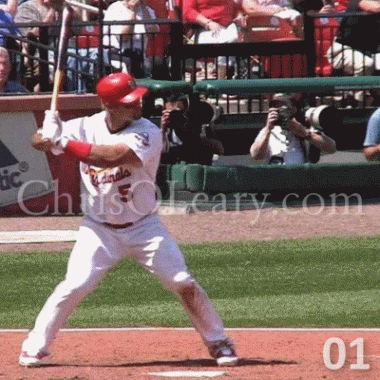 Albert
Pujols swing made him one of the greatest hitters to have ever
played the game, and this analysis looks at both why he was so good
and why he fell apart after leaving the Cardinals. Albert
Pujols swing made him one of the greatest hitters to have ever
played the game, and this analysis looks at both why he was so good
and why he fell apart after leaving the Cardinals.
We can learn a lot about hitting, and the
High-Level Swing,
by digging into Albert Pujols' swing, as
my experience with Andres Torres shows.
After the 2007 season, Torres
remained stuck in AAA, and he knew something had to change.
With the help of Chris O'Leary, a private hitting coach, he
began looking at all the video he could find on hitters he admired,
starting with Albert Pujols. He saw the way they generated power by
rotating through the pitch.
-
A Band of Misfits
Leveraging my
flipbook analysis of Albert Pujols
swing, Andres Torres was able to rebuild his swing and approach and
helped the Giants win the 2010 World Series.
Some of the key elements of Albert Pujols' swing I
emphasize include...
Albert Pujols Swing Analysis
Let me explain what a good swing actually
looks like using a clip of Albert Pujols hitting a home run
to left center field.
Before I do, let me give you some context.
The pitch was an 85 MPH fastball, right down the middle,
thrown by Livan Hernandez in the fifth inning on April 23, 2009.
The prior two pitches were 78 and 79 MPH sliders just outside.

Albert Pujols
Home Run Swing
The ball landed about seven rows up in the Left Field bleachers,
just a few seats in from the aisle and the grassy knoll in Center Field.
Rotation
The first thing to notice about Albert Pujols' swing is that it
is a perfect example of Rotational Hitting.
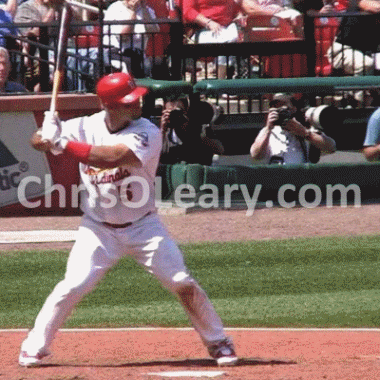
Albert Pujols
Home Run Swing
While many instructors think that Rotation will kill a swing, why
do I think it's important? Because of
my experience with Andres Torres.
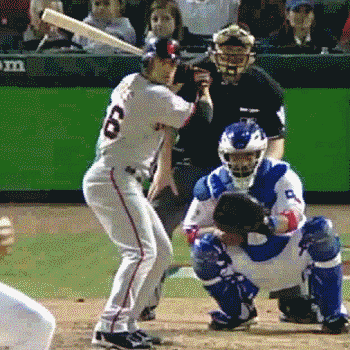
Andres Torres
Home Run to Right Field
Game 3 of the 2010 World Series
Andres felt that Rotation was one of
the concepts that led to his breakout.
I know about training, but hitting was difficult. And then in
’08... There’s a guy called Chris
O’Leary (a St. Louis fan who kept online
flipbooks breaking down
Pujols’ swing). He’s online. He talks about
Rotation. He's got video
examples of Pujols, and I watched those.
-
Andres Torres 2012
Who am I to argue with a major leaguer who helped the Giants win
the 2010 World Series?
Connection
Instead of hitting or catching the ball out front, at Extension,
Albert Pujols instead tended to hit the ball at Connection.
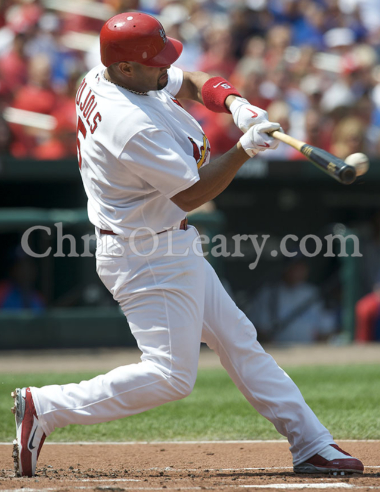
Albert Pujols
Demonstrating Connection
While that cost him some power, it was one of the reasons Pujols was
able to hit for BOTH Power and Average, at least during his time with
the Cardinals.
Extension: Why Not
Many baseball announcers and commentators are absolutely fixated
on the concept of Extension at the Point Of Contact (POC), but if you
look at the clip below you will see that Albert Pujols doesn't reach
full extension until Frame 13, which is well after the POC.

Albert Pujols
Frame 13
At the POC, Albert Pujols' back elbow is in a position
that is different than the Power V position that many of
Charley Lau's devotees preach and that I was taught
when I was learning to hit.[1]
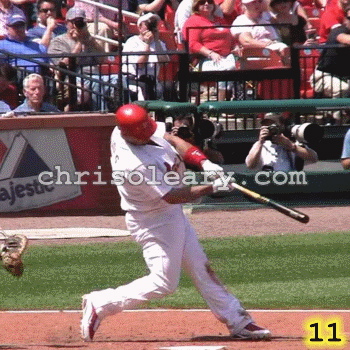
Albert Pujols
Frame 11
Pujols' bat and hands are then pulled out into
extension by the tremendous centrifugal force that he
generates during his swing.
Separation
Albert Pujols' swing is consistent with Ted Williams' principle
that the hips lead the hands and the modern concept of Separation.
Notice in Frame 8 that Albert Pujols' hips start
to open up while his hands stay up and back.
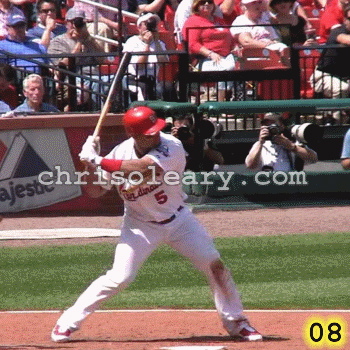
Albert Pujols
Frame 8
Once Pujols' hips have opened for a frame or two, his hands
then start to come around.
Hitch
The first thing to notice about Albert Pujols' swing is how short
it is, due to the
Hitch in his swing.
Because he is so short to the
ball, Albert Pujols has more time than the average
player to read the pitch. That gives Pujols more distance
and time to get a sense of what the pitch is and what it's going to do.
That increases the likelihood that he will be able to hit the ball squarely
and, as I will discuss in a moment, that is the key to Albert Pujols' ability
to hit for both average and power.
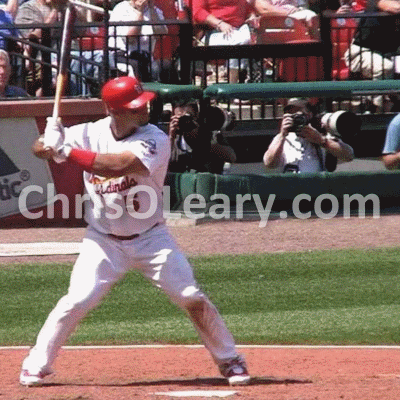
Albert Pujols
Home Run Swing
Of course, given the Hitch in his
swing, Albert Pujols' swing is a perfect illustration of how a
short swing is short from the standpoint of TIME, but not
necessarily DISTANCE.
Step
While it is true that Albert Pujols doesn't stride as
much as many players do — his STRIDE is actually
more of a STEP — if you watch what his front foot
does, you will see that he does or, as I discuss in my piece on
Albert Pujols'
stride, at least did, take a stride of nine inches or so.

Albert Pujols
Home Run Swing
More importantly, if you watch the movement of his back hip,
you will see that Albert Pujols still achieves a
sufficient weight shift and Rotation. Without his short but powerful weight shift,
Albert Pujols wouldn't be able to hit the ball as hard as he does.
Uppercut
One thing that you will hear constantly at any youth baseball
field is parents and coaches telling kids to, "Swing level."
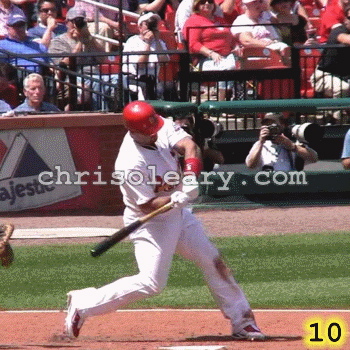
Albert Pujols
Frame 10
However, if you look at Frame 10 of the clip above, you will
see that Albert Pujols doesn't swing level to the ground.
No Bugs Were Squashed
You can also see in Frame 10 above that, rather than
squishing the bug, Albert Pujols' back toe is completely off the
ground at the POC. His back toe gets pulled off the ground by the extension
of his front knee and the resulting rapid rotation of his hips.
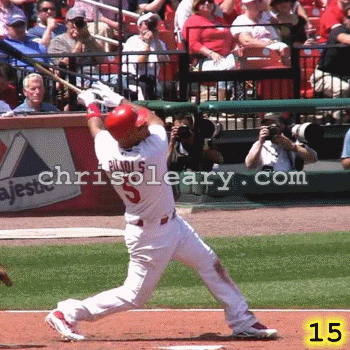
Albert Pujols
Frame 15
Pujols does eventually get to a position that looks like
squishing the bug, but he reaches that position in Frame 15,
which is well after the POC.
Albert Pujols and Steroids
What I see in Albert Pujols swing is a mechanically perfect swing.
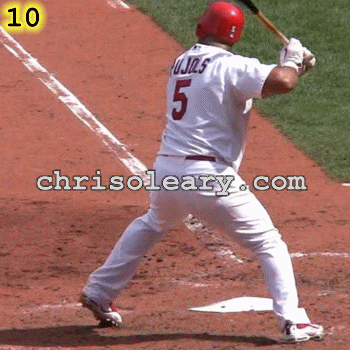
Albert Pujols
And a swing that is highly repeatable.
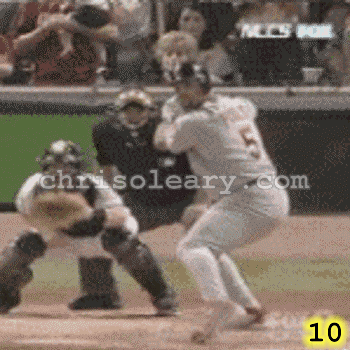
Albert Pujols
Even in his "bad" swings, meaning swings that result in outs,
he often misses the ball by as little as 1/8 of an inch.[2]

Albert Pujols
As a result, I absolutely believe
Albert Pujols when he says he doesn't use any illegal, performance-enhancing
substances. I think the best explanation for Albert Pujols' numbers is
once-in-a-generation talent, rather than steroids.
Why Albert Pujols Isn't Himself in Home Run Derbies
Based on a conversation with a professional client, and
his comments about the value of this section with respect to
Level of Effort, I have decided to move this section to
my
client site. To view the contents of this piece, you need
to
become a client.
About the Author
The ideas discussed in this and my related pieces on
Hitting...
...have helped transform the swings, approaches, and careers of multiple
major leagues hitters. With my help...
As Andres Torres said in 2012...
I know about training, but hitting was difficult.
And then in ’08... There’s a guy called Chris
O’Leary (a St. Louis fan who kept online
flipbooks
breaking down Pujols’ swing). He’s online. He talks
about Rotation. He's got
video
examples of Pujols, and I watched those.
-
Andres Torres 2012
Most recently, I helped reinvigorate the offense of
HSSU, an NAIA baseball team and HBC for whom I was the
Hitting Coordinator from February 2016 thru February 2017.
|
YEAR
|
AVG
|
SLG
|
OBP
|
|
2014
|
.298
|
.412
|
.369
|
|
2015
|
.263
|
.357
|
.350
|
|
2016
|
.311
|
.449
|
.400
|
|
2017
|
.334
|
.472
|
.420
|
|
2018
|
.286
|
.424
|
.387
|
|
2019
|
.276
|
.434
|
.354
|
While it pains me to see the guys at HSSU regress since I
left, I hope it makes it clear that I know what I'm talking about.
Become a Client
My clients have
access to my Streaming DVD and a number of other resources that
explain the High-Level Swing.
Notes
[1] If you read Charley Lau Sr.'s book "The Art of Hitting .300"
or view the related video, he never once talks about the concept of extension or
making the Power V at the Point Of Contact. However, the book is full of pictures
of George Brett doing just that...
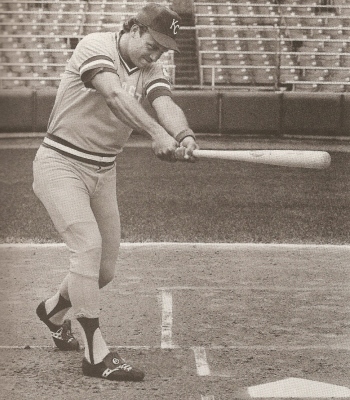
George Brett Demonstrating the Power V at the POC
...so it's not surprising that that is generally how the book is interpreted. Of course, if you go through George Brett's best swings frame by frame, you will see that they look nothing like the swing he demonstrates in Charley Lau Sr.'s book.
[2] The frame below is of a fly out to the right field
warning track (third pitch of first at bat on 7/31/2009). Albert Pujols is
in a mechanically perfect position in this frame. The result of the swing
was only an out, rather than a home run to right field, because Albert
chased a high pitch and got under the ball by maybe 1/8 of an inch (note
the position of the ball on the bat). To the
credit of the pitcher (Brian Moehler), he went up the ladder on Albert and
got him to chase a pitch just out of the top of the strike zone.
But talk about dodging a bullet.
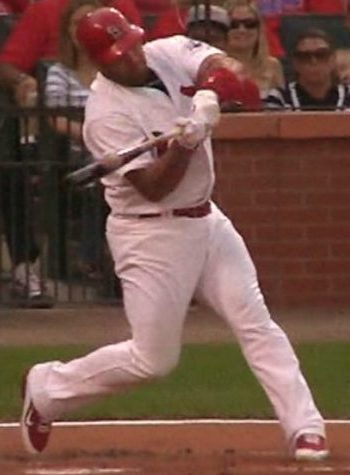
Albert Pujols Not Squishing The Bug
|















